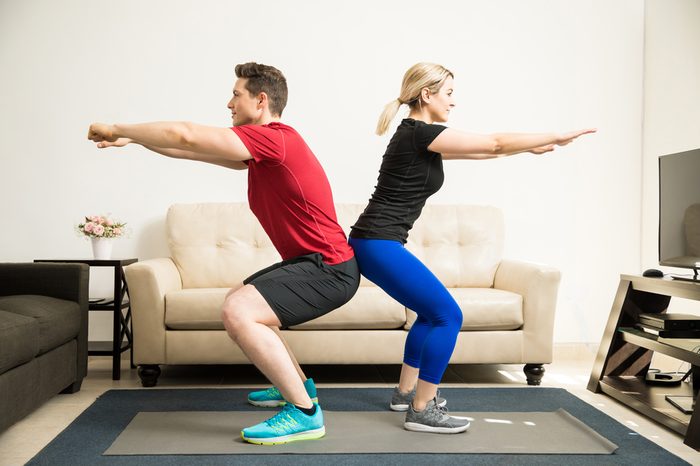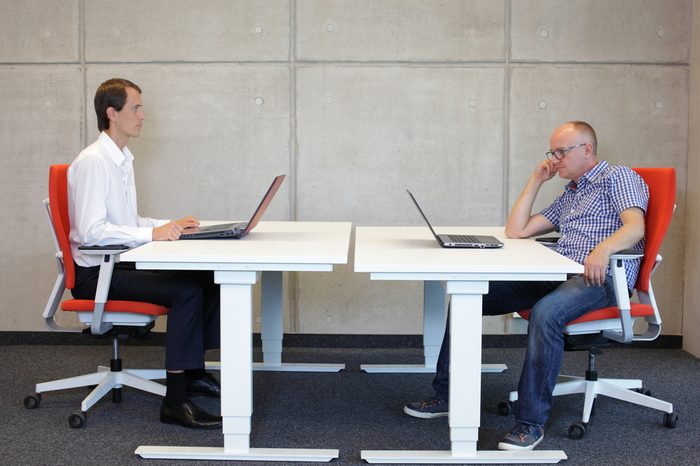
Squatting down improperly
Whether you’re picking up your child’s toys, weeding the garden, cleaning the floors, or doing something else that requires squatting, chances are you’re doing it wrong. Check to see if your knees come past your toes when squatting; if they do, this position is overloading your knee joints, and that can lead to discomfort and pain, says Karen Jacobs, OTR, CPE, a clinical professor of occupational therapy at Boston University. For proper form, start a squat with your feet shoulder-width apart, toes pointing forward, knees behind your toes, and your head up. “When you lower your body, pretend you’re sitting in a chair, and keep your knees aligned over the second or third toes, but not beyond,” says Jacobs. (Here are some more tips on how to perfect your squat form.)

Getting in and out of your car
“Although you may not realize it, depending on the size of your car you sometimes have to contort your body to fit inside and sit down low,” says Nina Black, head fitness director at Orangetheory Fitness. If you’re getting in and out multiple times a day, this can cause strain on your lower back, hip, and knees. To avoid it, says Black, brace yourself using your car door handle or steering wheel and lift with your arms as well as your legs.

Sitting at a desk all day
Many of us are sedentary for the majority of our day—and research has shown how harmful excessive sitting can be to our health. According to a study published in Annals of Internal Medicine, it can actually kill you. “Over many years, a sedentary lifestyle can have a detrimental effect on our bodies, leading to higher blood pressure and cardiovascular disease,” says Brittany Nugent, PT, DPT, clinical director at Professional Physical Therapy. To combat these effects, move more. Set a timer to get up every 30 minutes and walk around the office, or wear a fitness tracker and use its alarm to remind you to move.

Moving heavy objects on high shelves
Lifting anything heavy above your head—such as when you put away large dishes in cabinets or arrange heavy books on a shelf—can cause strain on your lower back, neck, and shoulders. To avoid this, organize your shelves according to the frequency of use. “The objects you use on a daily basis should be moved to lower shelves, which helps you avoid lifting things high above your head too often,” says Black. Another alternative: Use a step stool.

Wearing flip-flops
Besides getting your feet dirty and exposing them to germs and injury, wearing flip-flops on a regular basis can cause a multitude of other problems, including foot instability, tight calves, and knee pain, says Melissa DeVries, a certified personal trainer with a certification in corrective exercise. Save your flip-flops for the beach and wear closed-toe shoes with good arch support for your regular daily activities. Exercises like step-ups and lunges can also help improve foot and knee alignment, says DeVries. (Check out these reasons why you should never, ever wear flip-flops.)

Walking up or down stairs with your arms full
Trying to carry all your groceries or laundry in one trip is a disaster waiting to happen. A study published in Gait & Posture suggests that 41 percent of stair accidents coincide with distracted attention. “If you’re not able to see the steps or your feet below you, you’re at risk of missing a step and potentially slipping, jamming your toes, or worse, pulling a muscle or breaking a bone,” says Black. The solution: Make multiple trips to avoid unnecessary injuries, and try to always keep one hand free to hold onto the railing when walking up or down the stairs.

Hunching over devices
Adults now spend more than nine hours a day in front of screens, finds a study by Common Sense Media. “This can put excessive stress on your neck and low back, and it also closes down the joint space in our shoulders, which can cause rotator cuff impingement (pain),” says Nugent. Over time, this can even lead to a tear in your rotator cuff. Nugent recommends doing the “scap squeeze”—an exercise in which you sit as tall as you can on the edge of your seat and gently squeeze your shoulder blades down and back, holding for five seconds. Repeat 20 times. (Find out what blue light is doing to your body and your mental health.)

Getting out of bed too quickly
“Sometimes we sleep in awkward positions, and the next morning the body feels stiff and out of place, causing us to feel like we’ve had an unrestful night of sleep. If you get out of bed too quickly in the morning, you could strain your body,” says Black. Your back, feet, or neck pay the price, she warns. Instead of hopping out of bed, give yourself a good stretch before standing up. Slowly roll your wrists and ankles, then finish off with a gentle full-body stretch while laying on your back, recommends Black.

Constantly looking down at your phone
A problem that has surfaced over the last decade with the rise of smartphones is “text neck,” a term coined by authors of a study published in The Spine Journal. Your head weighs between 10 to 12 pounds: When you flex your neck to 60 degrees (the typical angle at which you look at your phone screen), you put about 60 pounds of force on your neck. Prevent soreness and injury by doing chin tucks, says Nugent. “Sit up straight in a chair, keeping your shoulders down. Pull your chin straight back without tilting your head; you’ll feel a stretch at the posterior of your neck,” she says. Hold this position for three to five seconds; repeat 15-20 times. Other ways to fix text neck: Hold your phone out in front of you at eye level or cut back on screen time.

Unloading the dishwasher
Throughout the day, you’re likely to do plenty of activities that force you to bend and rotate, for example when unloading the dishwasher or tidying up around the house. “When you perform repeated spinal flexion with rotation, like when you unload dishes, you are at higher risk of injuring the muscles, joints, or discs in your back,” says Nugent. Reduce your risk by bending with your knees and hips, pivoting your feet instead of twisting through your trunk, and coming to a standing position prior to rotating.

Carrying a heavy bag on your shoulder
Talk about excess baggage: Toting around a weighty laptop bag, purse, grocery tote, or backpack on a regular basis can hurt your spine and create muscle imbalance in your shoulders, says DeVries. She advises doing exercises to strengthen your back muscles, such as “Supermans” (lie on your belly, raising your arms and legs, like you’re Superman flying) along with single-arm chest and shoulder presses to help resolve muscle imbalances. And of course, lighten your load whenever possible, or alternate sides when carrying a bag. (Here’s more on how to carry your bag properly so your body doesn’t suffer.)

Sleeping on your stomach
This sleep position, while comfortable for many, is one of the worst because it causes you to turn your head to one side for hours. “This creates an imbalance in your neck muscles, strains your spinal joints, and can irritate the nerves in your neck—which can cause neck pain, headaches, and numbness in your arms and hands,” says Matthew Finke, DC, a consult physician at Laser Spine Institute. In addition, sleeping on one side of your face can lead to premature wrinkles, according to a study published in the Aesthetic Surgery Journal. Try working toward a supine sleep position instead. (Find out what your sleep habits reveal about your health.)

Standing in one place too long
A standing desk is a great way to combat the negative effects of too much sitting, but it comes with its own set of challenges. “Standing still in one place can often be more stressful on your low back than mild movements like walking,” says Andrea Lubaway Kneesi, DC, a chiropractic physician at Aligned Modern Health. This also applies if you’re waiting in long lines, such as the grocery store on Sunday evenings, or other activities that involve staying stationary, like watching your child’s soccer game. If you have no other option but to stand, assume a relaxed standing position with your knees slightly bent and hips tucked under your shoulders, says Dr. Kneesi. When using a standing desk, invest in an anti-fatigue mat to encourage continual shifting.
Next, learn the healthiest habits to implement in your everyday life.
